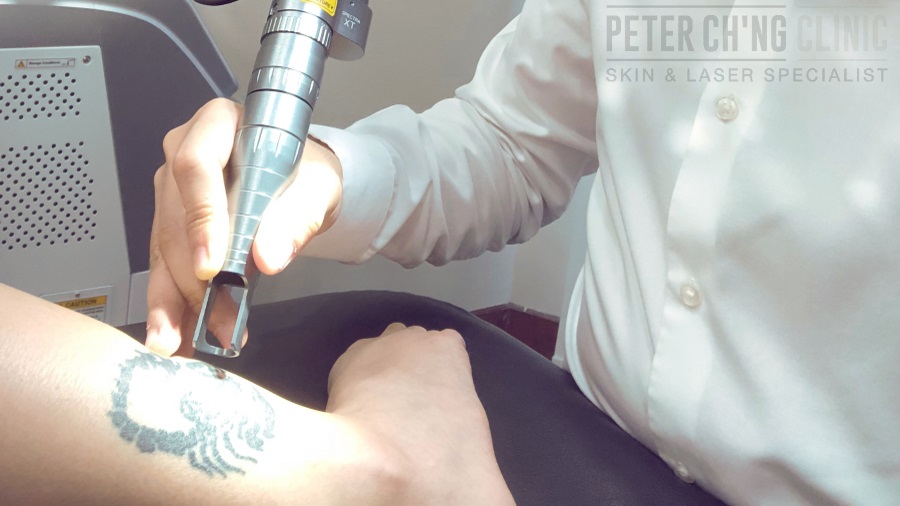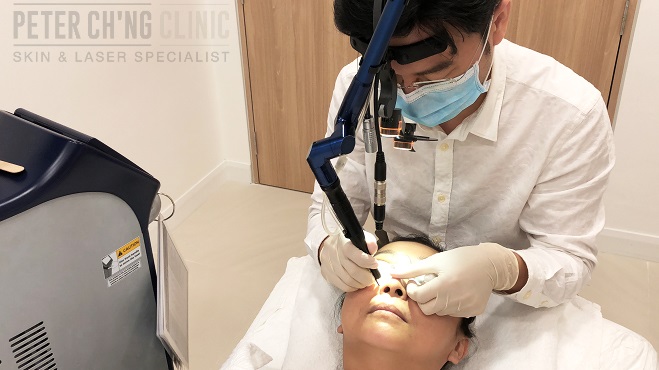Laser Treatments for Moles, Birthmarks & Tattoo

What are laser treatments for moles, birthmarks, and tattoo?
Not all birthmarks are formed at birth. Some develop birthmarks when they are born, and others develop them only after birth.
Birthmark growths also vary - some get smaller with time, while some grow proportionately to the person's physical growth.
There are 2 main types of birthmarks with their respective sub-types: pigmented birthmarks and vascular birthmarks. They can be removed using pigment lasers or vascular lasers.
Pigmented birthmarks are formed by pigment cells on a specific part of the skin. Some common types of pigmented birthmarks are lentigines, cafe au lait, and nevus. These can be treated with pigment lasers.
Unlike pigmented birthmarks, vascular birthmarks are not caused by pigment cells. Vascular means the heart and blood vessel system in our body, so vascular birthmarks are caused by blood vessels clumping together, forming a visible mark on the surface of our skin.
Some common types of vascular birthmarks are infantile haemangioma and port wine stain. These can be treated with vascular lasers.
Some birthmarks come in the shape of moles, but not all moles are birthmarks. Moles are small, round brown or black spots (usually not bigger than the size of a pencil eraser).
There are many different types of moles: some are flat, some are raised; some moles disappear as we grow, and some also appear along as we age.
However, if you notice your mole(s) changing in shape or colour, or if it itches or bleeds abnormally, you should check with our dermatologist or aesthetic doctor, Dr Peter and Dr Loo, and have a biopsy immediately to spot any possibilities of skin cancer.
For tattoos, it is for starters important to NOT use any DIY methods in removing tattoo. This is because the tattoo ink is tattooed into the middle layer of our skin. Therefore any DIY method to remove the tattoo will require us to enter into this level in our skin, and any meddling in the middle layer of our skin will cause scarring.
If we use chemical peeling like acid to peel the middle layer of the skin, we may be able to remove the tattoo, but end up with bad scarring. The same goes to any other methods like using fire to burn off the tattooed skin surface - the tattoo may disappear but we'd be left with severe damage and scarring on our skin.
How we do laser treatments for moles, birthmarks, and tattoo

The most important step in conducting a laser treatment is actually not the treatment itself, but in determining the type of mole, birthmark, or tattoo that you have.
Dr Loo and Dr Peter will thoroughly analyze your mole and birthmark to decide which treatment method is the most suitable for your condition, and also check if there are any underlying conditions behind the formation of these skin conditions, because safety and effectiveness is always the top priority.
The laser treatment itself doesn't take long, but several treatments may be needed for complete removal.
On the other hand, using a laser treatment, the tattoo ink and pigments with the tattoo will absorb the laser light.
With a laser tattoo removal treatment, we usually need several sessions to remove the tattoo completely, and each session is done one month apart with repeated procedures.
During the treatment, there may be some discomfort, but a numbing cream is used to reduce the discomfort prior to the treatment.
The tattoo will not disappear instantly after the laser treatment. In fact, after the laser treatment, the tattoo may become even darker in colour, and there may be a margin of redness surrounding the tattoo.
Then over the next couple of weeks, we can see the tattoo starting to lighten and slowly fade.
What to watch out for
If you notice your mole(s) changing in shape or colour, or if it itches or bleeds abnormally, you should check with our dermatologist or aesthetic doctor, Dr Peter and Dr Loo, and have a biopsy immediately to spot any possibilities of skin cancer.
We need to use different wavelength of lasers for different colour of tattoos. Otherwise, there may be complications. One common misconduct in laser tattoo removal is using the wrong laser wavelength for the wrong coloured tattoo.
As a result, there would be either no effect of tattoo removal, or complications like blisters and scarring can happen.
Knowing the skin type of the patients is also important, so that doctors know what laser to use, and what level of laser energy to be used for different skin types.
During the treatment, doctors also need to clearly know the endpoint of the procedure being carried out, to know whether to increase or decrease the laser energy throughout the treatment process.
This is why you should always only get your aesthetic treatments from certified medical doctors and professionals. Getting a laser treatment from unqualified practitioners can expose you to risks of complications you don't want on your skin and body!
To enquire more about Laser Treatments for Moles, Birthmarks & Tattoo, contact us or book an appointment here!
This treatment can treat the following conditions:

Moles, Birthmarks and Tattoo
Not all birthmarks and moles are formed at birth. Some develop them at birth, and others develop them only later in life. Effective treatment options depend on the type of birhtmarks and moles present on your skin. Tattoo inks are inked into the middle layer of our skin. So any DIY methods to remove the tattoo wouldn't be effective and may cause scarring. The safest and most effecive solution is a proper medical procedure.
Related treatments and services:
Laser Treatments for Acne and Acne Scars
Laser treatments can reduce inflammation, as the laser light is absorbed by the haemoglobin (our red blood cells), and is useful for treating inflammatory acne.
Laser Treatment for Stretch Marks
Stretch marks can appear anywhere where the skin has been stretched, but they usually affect areas where fat is stored, such as the tummy, breasts, upper arms, buttocks, thighs and shoulders. Honestly, it is actually impossible for our skin to return to its original condition once we develop stretch marks, but we can improve the condition via laser treatments.

Treatment for Warts & Skin Tags
Warts or skin tags can be benign growths or caused by virus and infection. There are different types of treatments that will be able to target the treatment area accurately.
